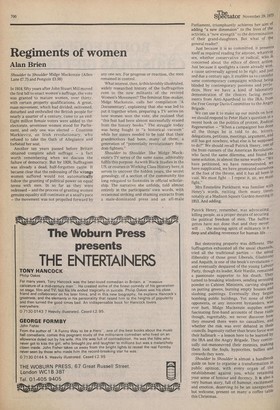Regiments of women
Alan Brien
Shoulder to Shoulder Midge Mackenzie (Allen Lane £7.75 and Penguin £3.50) In 1918, fifty years after John Stuart Mill moved the first bill to enact women's suffrage, the vote was granted to mature women, over thirty, with certain property qualifications. A great, mass movement, which had divided, enlivened, disturbed and enthralled the British people for nearly a quarter of a century, came to an end. Eight million female voters were added to the electorate, seventeen women stood for Parliament, and only one was elected — Countess Markievicz, an Irish revolutionary, who refused to take the Oath of Allegiance and forfeited her seat.
Another ten years passed before Britain obtained complete adult suffrage — a fact worth remembering when we discuss the failure of democracy. But by 1928, Suffragism was already a dead, half-forgotten cause. It became clear that the redressing of the wrongs women suffered would not automatically follow the granting of political power on equal terms with men. In so far as they were redressed — and the process of granting women genuine equality still continues at a snail's pace — the movement was not propelled forward by any one sex. For progress or reaction, the men remained in control.
What interest, then, is this lavishly illustrated, widely researched history of the Suffragettes even to the new militants of the revived Women's Movement? The feminist film-maker, Midge Mackenzie, calls her compilation 'A Documentary', explaining that she was led to put it together when, preparing a TV series on how women won the vote, she realised that "this feat had been almost successfully erased from the history books." The struggle today was being fought in "a historical vacuum" while her sisters needed to be told that their grandmothers had been, many of them, a generation of "potentially revolutionary freedom fighters."
Shoulder to Shoulder, like Midge Mackenzie's TV series of the same name, admirably fulfils this purpose. As with Black Studies in the US, or courses in Working Class History here, it serves to uncover the hidden years, the secret genealogy, of a section of the community too long relegated to footnotes in official scholarship. The narrative she unfolds, told almost entirely in the participants' own words, with occasional striking and shaming extracts from a male-dominated press and an all-male Parliament, triumphantly achieves her aim of adding "a new dimension" to the lives of the activists, a "new strength" to the determination of their grand-daughters. But what of the general reader?
Just because it is so committed, it presents itself as required reading for anyone, whatever sex, whether conservative or radical, who is concerned about the ethics of .direct action' Just because it spotlights a cause already vvon, a cause universally agreed to be right and just and due a century ago, it enables us to consider some contemporary campaigns without being blinded by contemporary passions and prejudices. Here we have a kind of laboratorY demonstration of the choices facing movements from Anti-Apartheid to the IRA, from the Free George Davis Committee to the Angry Brigade. We can use it to make up our minds on hoW we should respond to Peter Hain's question in a recent book on the politics of protest, Radical Regeneration — "When a campaigner has done all the things he is told to do, letters. delegations, petitions, meetings, argument, and still has got nowhere, what else is he supposed to do?" We should recall Patrick Henry, one of the front-runners of the American Revolution, who faced the same dilemma, and found the same solution, in almost the same words — "We have petitioned, we have remonstrated, We have supplicated, we have prostrated ourselves at the foot of the throne, and it has all been in vain'. We must fight — I repeat it, sir, we must fight." Mrs Emmeline Pankhurst was familiar with Henry's words, reciting them many times, notably at a Madison Square Garden meeting in 1913. And adding:
Patrick Henry, remember, was advocating killing people, as a proper means of securing the political freedom of men. The Suffragettes have not done that and they never will . . the moving spirit of militancy is a deep and abiding reverence for human life
But destroying property was different. The Suffragettes exhausted all the usual channels, tried all the traditional parties — the smug illiberality of those great Liberals, Gladstone and Asquith, is one of the book's revelations — and eventually despaired of the young Labour Party, though its leader, Keir Hardie, remained a passionate supporter to his death. TheY turned to breaking windows, sending sneezing powder to Cabinet Ministers, carving slogans on putting greens, burning empty houses and slashing paintings. Eventually they begat.' bombing public buildings. Yet none of their opponents, or any innocent bystanders. was ever hurt. Midge Mackenzie supplies some fascinating first-hand accounts of these raids though, regrettably, we never discover hoW they ensured there were no casualties, and whether the risk was ever debated in their councils. Ingenuity rather than brute force was their hallmark — a lesson here to be learned bY the IRA and the Angry Brigade. They continually out-manoeuvred their enemies, making them look the fools, hypocrites, bullies and cowards they were. Shoulder to Shoulder is almost a handbook guide on how to organise a transformation in public opinion, with every organ of the establishment against you, while retaining your sense of honour and decency. It is also a very human story, full of humour, excitement and emotion, deserving to be an unexpected, but welcome, present on many a coffee table this Christmas.


































 Previous page
Previous page